- Home
- Alice Munro
The Love of a Good Woman
The Love of a Good Woman Read online
ACCLAIM FOR Alice Munro’s
THE LOVE OF
A GOOD WOMAN
“Masterly … miraculous in their detail and startlingly true to life…. Munro demonstrates an understanding of human nature that goes beyond what the rest of us are ordinarily able to grasp.”
—The Wall Street Journal
“Splendid … spectacular … [Munro is] a writer for the ages.”
—Newsday
“Full-blooded … beguiling … [Munro] seems to write whole novels in a few thousand words and leaves you wondering what conventional novelists do with all those extra pages.”
—The Philadelphia Inquirer
“Alice Munro is one of the best short-story writers working today. Her tales leave one musing over the secret of a magic which is her own.”
—The Washington Times
“Shimmering … emotionally rending … [Munro] attacks big themes—love and death, passion and betrayal, expectation and disappointment—in richly detailed, unassuming prose.”
—The San Diego Union-Tribune
“Munro’s austere and magisterial stories of lust and loss are, if anything, more enigmatic than ever, and yet their opacity occasionally gestures toward something akin to hope.”
—The New Yorker
“Astonishing … thrillingly unpredictable Munro is not only one of the world’s greatest writers, she’s also one of its toughest, fearlessly exploring the difficult truths of female experience.”
—Francine Prose, Elle
“A triumph … her books get better and better, spilling with the kind of secrets we instantly recognize, and with generous consolations as well.”
—Mirabella
“Munro’s fiction is intelligence-gathering of a high order that feeds the reader’s need to know but never violates or debases the essential mystery that is at the source of all great art…. She has brought to light some of the most beautifully embellished, long short fictional shapes this century has seen.”
—Chicago Tribune
“[Munro’s] stories are like pulsars, a few dazzling teaspoons of which weigh tons … all the complexity and nuance of a novel, concentrated within several dozen pages.”
—The Plain Dealer
“She is our Chekhov, and is going to outlast most of her contemporaries.”
—Cynthia Ozick
Alice Munro
THE LOVE OF
A GOOD WOMAN
Alice Munro grew up in Wingham, Ontario, and attended the University of Western Ontario. She has published more than ten collections of stories, as well as a novel, Lives of Girls and Women. During her distinguished career she has been the recipient of many awards and prizes, including three Governor General’s Literary Awards—Canada’s highest; the Lannan Literary Award; the W. H. Smith Award, given to Open Secrets as the best book published in the United Kingdom in 1995; and the National Book Critics Circle Award for The Love of a Good Woman. Her stories have appeared in The New Yorker, The Atlantic Monthly, The Paris Review, and other publications, and her collections have been translated into thirteen languages. Alice Munro and her husband divide their time between Clinton, Ontario, near Lake Huron, and Comox, British Columbia.
ALSO BY Alice Munro
Selected Stories
Open Secrets
Friend of My Youth
The Progress of Love
The Moons of Jupiter
The Beggar Maid
Something I’ve Been Meaning to Tell You
Lives of Girls and Women
Dance of the Happy Shades
For Ann Close
My valued editor and constant friend
AUTHOR’S NOTE
For certain expert information essential to these stories, my thanks to Ruth Roy, Mary Carr, and D. C. Coleman. And for his inspired and ingenious research on many occasions, I thank Reg Thompson.
Stories included in this collection that were previously published in The New Yorker appeared there in very different form.
CONTENTS
The Love of a Good Woman
Jakarta
Cortes Island
Save the Reaper
The Children Stay
Rich As Stink
Before the Change
My Mother’s Dream
THE LOVE OF
A GOOD WOMAN
FOR the last couple of decades, there has been a museum in Walley, dedicated to preserving photos and butter churns and horse harnesses and an old dentist’s chair and a cumbersome apple peeler and such curiosities as the pretty little porcelain-and-glass insulators that were used on telegraph poles.
Also there is a red box, which has the letters D. M. WILLENS, OPTOMETRIST printed on it, and a note beside it, saying, “This box of optometrist’s instruments though not very old has considerable local significance, since it belonged to Mr. D. M. Willens, who drowned in the Peregrine River, 1951. It escaped the catastrophe and was found, presumably by the anonymous donor, who dispatched it to be a feature of our collection.”
The ophthalmoscope could make you think of a snowman. The top part, that is—the part that’s fastened onto the hollow handle. A large disk, with a smaller disk on top. In the large disk a hole to look through, as the various lenses are moved. The handle is heavy because the batteries are still inside. If you took the batteries out and put in the rod that is provided, with a disk on either end, you could plug in an electric cord. But it might have been necessary to use the instrument in places where there wasn’t any electricity.
The retinoscope looks more complicated. Underneath the round forehead clamp is something like an elf’s head, with a round flat face and a pointed metal cap. This is tilted at a forty-five-degree angle to a slim column, and out of the top of the column a tiny light is supposed to shine. The flat face is made of glass and is a dark sort of mirror.
Everything is black, but that is only paint. In some places where the optometrist’s hand must have rubbed most often, the paint has disappeared and you can see a patch of shiny silver metal.
I. JUTLAND
THIS place was called Jutland. There had been a mill once, and some kind of small settlement, but that had all gone by the end of the last century, and the place had never amounted to much at any time. Many people believed that it had been named in honor of the famous sea battle fought during the First World War, but actually everything had been in ruins years before that battle ever took place.
The three boys who came out here on a Saturday morning early in the spring of 1951 believed, as most children did, that the name came from the old wooden planks that jutted out of the earth of the riverbank and from the other straight thick boards that stood up in the nearby water, making an uneven palisade. (These were in fact the remains of a dam, built before the days of cement.) The planks and a heap of foundation stones and a lilac bush and some huge apple trees deformed by black knot and the shallow ditch of the millrace that filled up with nettles every summer were the only other signs of what had been here before.
There was a road, or a track, coming back from the township road, but it had never been gravelled, and appeared on the maps only as a dotted line, a road allowance. It was used quite a bit in the summer by people driving to the river to swim or at night by couples looking for a place to park. The turnaround spot came before you got to the ditch, but the whole area was so overrun by nettles, and cow parsnip, and woody wild hemlock in a wet year, that cars would sometimes have to back out all the way to the proper road.
The car tracks to the water’s edge on that spring morning were easy to spot but were not taken notice of by these boys, who were thinking only about swimming. At least, they would call it swimming; they would go back to town and say that they had been
swimming at Jutland before the snow was off the ground.
It was colder here upstream than on the river flats close to the town. There was not a leaf out yet on the riverbank trees—the only green you saw was from patches of leeks on the ground and marsh marigolds fresh as spinach, spread along any little stream that gullied its way down to the river. And on the opposite bank under some cedars they saw what they were especially looking for—a long, low, stubborn snowbank, gray as stones.
Not off the ground.
So they would jump into the water and feel the cold hit them like ice daggers. Ice daggers shooting up behind their eyes and jabbing the tops of their skulls from the inside. Then they would move their arms and legs a few times and haul themselves out, quaking and letting their teeth rattle; they would push their numb limbs into their clothes and feel the painful recapture of their bodies by their startled blood and the relief of making their brag true.
The tracks that they didn’t notice came right through the ditch—in which there was nothing growing now, there was only the flat dead straw-colored grass of the year before. Through the ditch and into the river without trying to turn around. The boys tramped over them. But by this time they were close enough to the water to have had their attention caught by something more extraordinary than car tracks.
There was a pale-blue shine to the water that was not a reflection of sky. It was a whole car, down in the pond on a slant, the front wheels and the nose of it poking into the mud on the bottom, and the bump of the trunk nearly breaking the surface. Light blue was in those days an unusual color for a car, and its bulgy shape was unusual, too. They knew it right away. The little English car, the Austin, the only one of its kind surely in the whole county. It belonged to Mr. Willens, the optometrist. He looked like a cartoon character when he drove it, because he was a short but thick man, with heavy shoulders and a large head. He always seemed to be crammed into his little car as if it was a bursting suit of clothes.
The car had a panel in its roof, which Mr. Willens opened in warm weather. It was open now. They could not see very well what was inside. The color of the car made its shape plain in the water, but the water was really not very clear, and it obscured what was not so bright. The boys squatted down on the bank, then lay on their stomachs and pushed their heads out like turtles, trying to see. There was something dark and furry, something like a big animal tail, pushed up through the hole in the roof and moving idly in the water. This was shortly seen to be an arm, covered by the sleeve of a dark jacket of some heavy and hairy material. It seemed that inside the car a man’s body—it had to be the body of Mr. Willens—had got into a peculiar position. The force of the water—for even in the millpond there was a good deal of force in the water at this time of year—must have somehow lifted him from the seat and pushed him about, so that one shoulder was up near the car roof and one arm had got free. His head must have been shoved down against the driver’s door and window. One front wheel was stuck deeper in the river bottom than the other, which meant that the car was on a slant from side to side as well as back to front. The window in fact must have been open and the head sticking out for the body to be lodged in that position. But they could not get to see that. They could picture Mr. Willens’s face as they knew it—a big square face, which often wore a theatrical sort of frown but was never seriously intimidating. His thin crinkly hair was reddish or brassy on top, and combed diagonally over his forehead. His eyebrows were darker than his hair, thick and fuzzy like caterpillars stuck above his eyes. This was a face already grotesque to them, in the way that many adult faces were, and they were not afraid to see it drowned. But all they got to see was that arm and his pale hand. They could see the hand quite plain once they got used to looking through the water. It rode there tremulously and irresolutely, like a feather, though it looked as solid as dough. And as ordinary, once you got used to its being there at all. The fingernails were all like neat little faces, with their intelligent everyday look of greeting, their sensible disowning of their circumstances.
“Son of a gun,” these boys said. With gathering energy and a tone of deepening respect, even of gratitude. “Son of a gun.”
IT was their first time out this year. They had come across the bridge over the Peregrine River, the single-lane double-span bridge known locally as Hell’s Gate or the Death Trap—though the danger had really more to do with the sharp turn the road took at the south end of it than with the bridge itself.
There was a regular walkway for pedestrians, but they didn’t use it. They never remembered using it. Perhaps years ago, when they were so young as to be held by the hand. But that time had vanished for them; they refused to recognize it even if they were shown the evidence in snapshots or forced to listen to it in family conversation.
They walked now along the iron shelf that ran on the opposite side of the bridge from the walkway. It was about eight inches wide and a foot or so above the bridge floor. The Peregrine River was rushing the winter load of ice and snow, now melted, out into Lake Huron. It was barely back within its banks after the yearly flood that turned the flats into a lake and tore out the young trees and bashed any boat or hut within its reach. With the runoff from the fields muddying the water and the pale sunlight on its surface, the water looked like butterscotch pudding on the boil. But if you fell into it, it would freeze your blood and fling you out into the lake, if it didn’t brain you against the buttresses first.
Cars honked at them—a warning or a reproof—but they paid no attention. They proceeded single file, as self-possessed as sleepwalkers. Then, at the north end of the bridge, they cut down to the flats, locating the paths they remembered from the year before. The flood had been so recent that these paths were not easy to follow. You had to kick your way through beaten-down brush and jump from one hummock of mud-plastered grass to another. Sometimes they jumped carelessly and landed in mud or pools of leftover floodwater, and once their feet were wet they gave up caring where they landed. They squelched through the mud and splashed in the pools so that the water came in over the tops of their rubber boots. The wind was warm; it was pulling the clouds apart into threads of old wool, and the gulls and crows were quarrelling and diving over the river. Buzzards were circling over them, on the high lookout; the robins had just returned, and the red-winged blackbirds were darting in pairs, striking bright on your eyes as if they had been dipped in paint.
“Should’ve brought a twenty-two.”
“Should’ve brought a twelve-gauge.”
They were too old to raise sticks and make shooting noises. They spoke with casual regret, as if guns were readily available to them.
They climbed up the north banks to a place where there was bare sand. Turtles were supposed to lay their eggs in this sand. It was too early yet for that to happen, and in fact the story of turtle eggs dated from years back—none of these boys had ever seen any. But they kicked and stomped the sand, just in case. Then they looked around for the place where last year one of them, in company with another boy, had found a cow’s hipbone, carried off by the flood from some slaughter pile. The river could be counted on every year to sweep off and deposit elsewhere a good number of surprising or cumbersome or bizarre or homely objects. Rolls of wire, an intact set of steps, a bent shovel, a corn kettle. The hipbone had been found caught on the branch of a sumac—which seemed proper, because all those smooth branches were like cow horns or deer antlers, some with rusty cone tips.
They crashed around for some time—Cece Ferns showed them the exact branch—but they found nothing.
It was Cece Ferns and Ralph Diller who had made that find, and when asked where it was at present Cece Ferns said, “Ralph took it.” The two boys who were with him now—Jimmy Box and Bud Salter—knew why that would have to be. Cece could never take anything home unless it was of a size to be easily concealed from his father.
They talked of more useful finds that might be made or had been made in past years. Fence rails could be used to build a raft, pieces of
stray lumber could be collected for a planned shack or boat. Real luck would be to get hold of some loose muskrat traps. Then you could go into business. You could pick up enough lumber for stretching boards and steal the knives for skinning. They spoke of taking over an empty shed they knew of, in the blind alley behind what used to be the livery barn. There was a padlock on it, but you could probably get in through the window, taking the boards off it at night and replacing them at daybreak. You could take a flashlight to work by. No—a lantern. You could skin the muskrats and stretch the pelts and sell them for a lot of money.
This project became so real to them that they started to worry about leaving valuable pelts in the shed all day. One of them would have to stand watch while the others went out on the traplines. (Nobody mentioned school.)
This was the way they talked when they got clear of town. They talked as if they were free—or almost free—agents, as if they didn’t go to school or live with families or suffer any of the indignities put on them because of their age. Also, as if the countryside and other people’s establishments would provide them with all they needed for their undertakings and adventures, with only the smallest risk and effort on their part.
Another change in their conversation out here was that they practically gave up using names. They didn’t use each other’s real names much anyway—not even family nicknames such as Bud. But at school nearly everyone had another name, some of these having to do with the way people looked or talked, like Goggle or Jabber, and some, like Sore-arse and Chickenfucker, having to do with incidents real or fabulous in the lives of those named, or in the lives—such names were handed down for decades—of their brothers, fathers, or uncles. These were the names they let go of when they were out in the bush or on the river flats. If they had to get one another’s attention, all they said was “Hey.” Even the use of names that were outrageous and obscene and that grown-ups supposedly never heard would have spoiled a sense they had at these times, of taking each other’s looks, habits, family, and personal history entirely for granted.

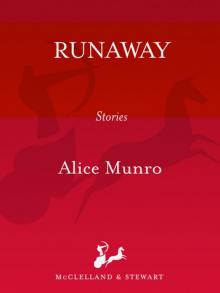 Runaway
Runaway Lives of Girls and Women
Lives of Girls and Women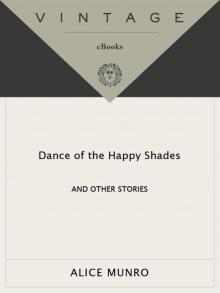 Dance of the Happy Shades
Dance of the Happy Shades Open Secrets
Open Secrets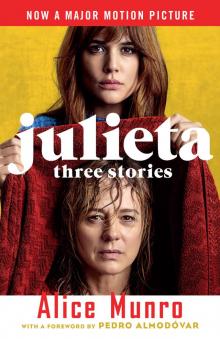 Julieta (Movie Tie-in Edition)
Julieta (Movie Tie-in Edition)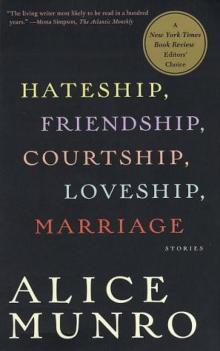 Hateship, Friendship, Courtship, Loveship, Marriage: Stories
Hateship, Friendship, Courtship, Loveship, Marriage: Stories Alice Munro's Best
Alice Munro's Best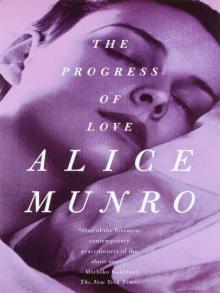 The Progress of Love
The Progress of Love Selected Stories
Selected Stories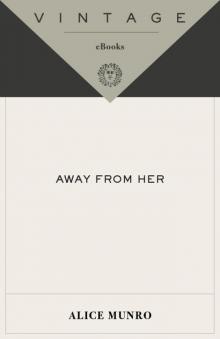 Away from Her
Away from Her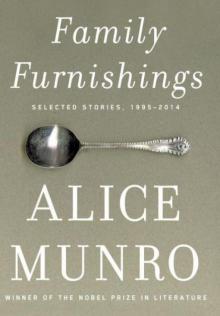 Family Furnishings
Family Furnishings Moons of Jupiter
Moons of Jupiter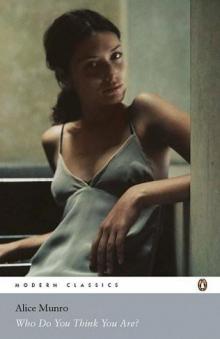 Who Do You Think You Are?
Who Do You Think You Are? Hateship, Friendship, Courtship, Loveship, Marriage
Hateship, Friendship, Courtship, Loveship, Marriage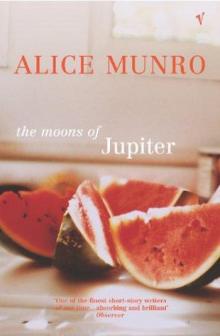 The Moons of Jupiter
The Moons of Jupiter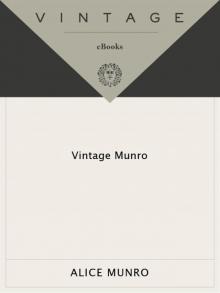 Vintage Munro
Vintage Munro The Love of a Good Woman
The Love of a Good Woman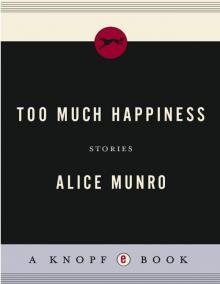 Too Much Happiness
Too Much Happiness Lying Under the Apple Tree
Lying Under the Apple Tree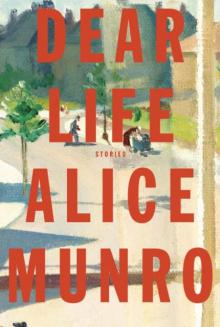 Dear Life
Dear Life Dear Life: Stories
Dear Life: Stories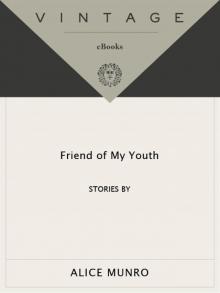 Friend of My Youth
Friend of My Youth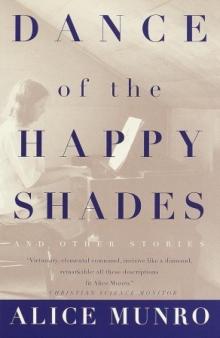 Dance of the Happy Shades: And Other Stories
Dance of the Happy Shades: And Other Stories The Beggar Maid
The Beggar Maid